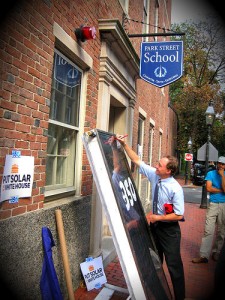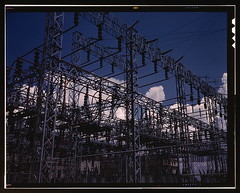A recent Sierra Club magazine article illustrates, in a unique diagram, how the United States, with 4.5% of the world’s population, is responsible for nearly 20% of global carbon dioxide emissions. In fact, state by state, U.S. CO2 output equals that of entire countries, as illustrated on the map. Data are from the 2007 U.S. Energy Information Administration.
Category Archives: Massachusetts
Massachusetts Plans for the Clean Energy Future
On December 29th, Massachusetts officials announced a state-wide plan to cut heat-trapping carbon gases emitted by homes, cars and businesses in the state by 25 percent below 1990 levels over the next decade. The targets set by the plan are the highest allowed under climate legislation passed by the state in 2008 and among the most stringent in the nation. This aligns Massachusetts with states like California and New Mexico, who have already announced similar action.
The Massachusetts plan relies mainly on existing programs such as energy-efficiency standards for building construction, renewable-energy mandates and curbs in the electricity sector under the Regional Greenhouse Gas Initiative, of which Massachusetts is a signatory. Ian Bowles, the state’s energy and environmental secretary, highlighted that the plan is an example of how a state can alter its energy profile with minimal economic impact and predicts instead a net gain in jobs for Massachusetts in the clean energy sector.
Debra Boronski, president of the Massachusetts Chamber of Business and Industry, has doubts about the plan stating, “Our biggest concern — even though it is right to conserve energy — is that alternative resources have to be cost-effective … As far as we know, in Massachusetts, research has shown that alternative energy is more expensive.”
Interestingly, data released by state officials indicated that more than one-third of the total greenhouse-gas emissions in Massachusetts come from the transportation sector. In response to this information, Mr. Bowles announced the state will begin a pilot “Pay As You Drive” program giving drivers an incentive to cut back on unnecessary travel by linking car-insurance premiums to miles driven. Congress has authorized $15 million in grants to insure low-income drivers do not suffer an unequal burden.
Other energy options include hydroelectric power from Quebec, weatherization for resident homes, and economic incentives for homeowners to replace oil-fueled furnaces with more efficient models.
—-
Cambridge Energy Alliance is available to help guide you through the above-mentioned process of weatherization as well as retrofitting your home- all starting with signing you up to have your home looked at. If you would like to take advantage of your free energy assessment (which you have each already paid for via utility bills), please head to the CEA sign-up page, or call their Energy Advising line at 1-617-491-0488, extension 121 today!
Clean Water Woes in Boston
In a breaking news article, the Boston Globe reported that the Boston Water and Sewer Commission is releasing polluted water into area rivers, including the Charles, Neponset and Mystic, all of which flow into Boston Harbor. Massachusetts US Attorney Carmen Ortiz and the Environmental Protection Agency’s New England office alleged the Commission is acting in violation of the federal Clean Water Act. Federal agencies are poised to take legal action in February following an official lawsuit by the Conservation Law Foundation. CLF said the lawsuit “documents serious failures in the system that are allowing ongoing unlawful pollution of Boston’s waterway.” A statement by the Boston Water and Sewer Commission evaded direct mention of the allegation commenting “We have no comments on the specifics, however, the commission takes its role as an environmental steward as seriously as any other and is proud of its contributions to the resurgence of Boston Harbor and the Waterfront.’’ Whatever the official findings, federal intervention marks the severity of the situation and the lawsuit carries an important message: clean water is a basic human and environmental right which must be upheld and respected.
Power Hungry US
In a recent post by GOOD, a detailed breakdown of 2008 energy consumption in the US illustrates the range of energy use across the country by state. According to this data, Massachusetts comes in with 1.00 – 1.49 quadrillion BTUs of total energy consumption, while California or Texas, for example, come in at more than 2.50 each. The graph also breaks down total energy consumption by person, or per capita. How does your state measure up?
The Fate of Vermont Yankee
The Vermont Yankee nuclear power plant, located in the town of Vernon on the boarder of Massachusetts and Vermont, has been a topic of environmental concern and debate for many years. On Sunday, November 7th, the plant shut down due to a cooling water leak, but was back online to the New England grid early next Thursday morning.
Local residents and politicians, fearing the dated, aging plant could lead to potential nuclear disaster, have been pushing to permanently close the plant for years. In fact, the consensus in the Vermont Legislature is that Vermont Yankee should be closed when its 40-year license expires in March, 2012. Entergy, the Louisiana-based power company that owns the plant, has since put the reactor on the market as of last week given the continued resistance by the state of Vermont. Nonetheless, the fate of Vermont Yankee remains somewhat unclear.
The Brattleboro Reformer reported Thursday that in nearby Keene, NH, city officials are debating whether to sign a letter asking to be involved in decisions on how the reactor would be torn down. Clearly the push to close Vermont Yankee is significant, particularly when neighboring states express concern and take action. The question however remains: if Vermont Yankee shuts down, what alternative energy source will take its place? For now, the focus is the closure of an archaic power plant. What would ensue remains open for discussion and debate.
Green Medford: Reverse Trick or Treat Bewitches Columbus School Neighborhood
 What would you do if your doorbell rang on Halloween and instead of saying “trick or treat!” your visitors handed you a new, curly-cue light bulb (or two)? This year’s Halloween saw an event that was a brand new take on the usual compact fluorescent light bulb canvasses that the CEA hosts. We are thrilled to see that this creative event went off without a hitch, and that it has set a great precedent for following years!
What would you do if your doorbell rang on Halloween and instead of saying “trick or treat!” your visitors handed you a new, curly-cue light bulb (or two)? This year’s Halloween saw an event that was a brand new take on the usual compact fluorescent light bulb canvasses that the CEA hosts. We are thrilled to see that this creative event went off without a hitch, and that it has set a great precedent for following years!
Please see below for the post featured on the Green Medford blog:
A group of us from Green Medford and Fletcher Green (a Tufts graduate student group) trolled the streets around the Columbus School last night–Halloween evening–handing out bags of treats to delighted and laughing residents at 84 addresses. People who answered their doors expecting to give out candy were instead handed a bag containing two new energy-efficient lights. Event participant “Sherlock Holmes” noted, “It was gratifying to see how surprised and happy this made people.”
One resident told us, “This is such a great idea! We recently switched all of our bulbs to CFLs and are saving $60 a month.” She turned to her neighbor and said, “You have to take some. This is amazing!”
We gave out more than 180 CFLs that were donated by National Grid and the Tufts Office of Community Relations. The First Annual Medford Reverse Trick or Treat exceeded our expectations, and we are already looking forward to expanding on our success with a bigger event next year!
Thanks so much to all the sponsors and others who helped organize this event, especially JR Siegel, Allie Lipps, Becky Hemperly, Kim Wardwell, Catherine Smith, Alicia Hunt, Brad Steele of EFI, and Barbara Rubel at the Tufts Office of Community Relations.
Susan Altman
Green Medford
Reverse trick-or-treat CFL event!
 The Cambridge Energy Alliance has participated in many CFL exchange canvasses. On a chosen day, we and volunteers head out into neighborhoods and knock on doors, offering to give an equal number of CFLs for the number of regular light bulbs a household will hand us. As a special treat with Halloween approaching, Green Medford has announced an event that is a new take on this idea.
The Cambridge Energy Alliance has participated in many CFL exchange canvasses. On a chosen day, we and volunteers head out into neighborhoods and knock on doors, offering to give an equal number of CFLs for the number of regular light bulbs a household will hand us. As a special treat with Halloween approaching, Green Medford has announced an event that is a new take on this idea.
From the Green Medford blog:
Hi all! I want to share with you a very fun idea and ask for your help in making it a big success!
We’re calling our event “Reverse Trick or Treat,” thought up by JR Siegel, a student at the Fletcher School and a Medford resident. The idea is for a bunch of residents to get together on Halloween, hopefully including kids, to make it more fun for everyone.
Dressed in fun costumes (but nothing too scary), teams of two or three (no kids without an adult) will ring doorbells in a residential neighborhood during trick or treating time. We’ve been given several hundred energy-efficient lights (CFLs) by National Grid and Tufts to give away to folks who answer their doors. The more of us there are to participate, the more bulbs we can give out. The kids, of course, will do regular trick or treating at the same time!
We want to focus on a neighborhood with lots of families that might not already have CFLs or know all they need to about saving electricity and money by switching to energy-efficient lights.
We also would like to find a reporter to walk around with us and take pictures and talk to people about the event.
In addition to us in Green Medford, we already have all these sponsors committed!
EFI/National Grid, Tufts University Office of Community Affairs, Fletcher Green (a student group at Fletcher School of Law and Diplomacy/Tufts), and the Medford Energy and Environment Office.
Please join us! Contact Susan Altman, Green Medford, susan.altman@comcast.net, 781-395-4664, or J.R. Siegel, Fletcher Green, j.r.siegel@gmail.com.
Happy Halloweeeeeeeen!
Greening America’s Capitals – Boston and Hartford
 As recently reported by GreenBiz, Boston and Hartford have been chosen by the Environmental Protection Agency (EPA) as two of the five cities that will partake in the Greening America’s Capitals program. This is great news as it means a team of EPA backed designers will visit each city and will create and design plans that promote smart growth and will help ensure the future sustainability for both capitals.
As recently reported by GreenBiz, Boston and Hartford have been chosen by the Environmental Protection Agency (EPA) as two of the five cities that will partake in the Greening America’s Capitals program. This is great news as it means a team of EPA backed designers will visit each city and will create and design plans that promote smart growth and will help ensure the future sustainability for both capitals.
In conjunction with the U.S Department of House and Development and the U.S. Department of Transportation, the EPA will provide all five cities with plans for “high-quality green development that includes cleaning up and recycling vacant lands, accessing and improving waterways, providing greater housing and transportation choices, and reducing infrastructure and energy costs.”
Specifically, the press release notes that Boston “asked for assistance through EPA Greening America’s Capitals to create realistic greening options for City Hall Plaza that can be realized in the near term. Goals of the redesign will be to create well-defined edges and entrances, provide more bike access and parking, connect the plaza to existing streets, increase green elements such as trees and vegetation for better stormwater management, and support energy efficiency and green building improvements in City Hall and nearby buildings.”
As for Hartford, the program “will help Hartford staff and stakeholders create a redevelopment plan for the Capitol Avenue corridor and connections to nearby locations, such as the Frog Hollow neighborhood and a proposed Sigourney Street bus rapid transit station. Redesigns will focus on public open spaces, such as parks and state building grounds, as well as green street improvements that better manage stormwater, improve the pedestrian environment and aesthetic character of Capitol Avenue, and encourage future redevelopment.”
Along with Boston and Hartford, the three other cities chosen to receive this award are Charleston, WV, Jefferson City, MO, and Little Rock, AK. These cities beat out numerous others for this assistance and we are thrilled that of the pilot cities, two are GreenScene cities in New England. Congratulations to all the five capitals!
350.org Solar Road Trip to White House
 Beginning September 7th, Bill McKibben and students from Unity College in Maine are on a road trip to Washington D.C., with a specific goal in mind. This 350.org-affiliated group plans to approach the White House to urge President Obama to install solar panels on his roof in order to finally make a stand on energy issues, set an example for citizens, and to participate in 350.org’s “Global Work Party” on October 10th (10-10-10).
Beginning September 7th, Bill McKibben and students from Unity College in Maine are on a road trip to Washington D.C., with a specific goal in mind. This 350.org-affiliated group plans to approach the White House to urge President Obama to install solar panels on his roof in order to finally make a stand on energy issues, set an example for citizens, and to participate in 350.org’s “Global Work Party” on October 10th (10-10-10).
In 1979, President Jimmy Carter put solar panels on the White House. In 1986, President Reagan removed them and they were never replaced. Years later, Unity College in Maine adopted the panels where they have lived ever since. Until now.
Unity College has removed one panel from their cafeteria roof and donated it to 350.org’s campaign to convince President Obama to put solar back on the White House roof.
The road tripping group is carrying with them the one historical solar panel, a public message, and a promise from a company who will donate a slew of new panels to populate the rest of the roof with as long as the President agrees to take the challenge.
As a way of bringing awareness to the mission and garnering support with which to face the White House, the bio-diesel-powered caravan has made stops along the way in Boston and New York City. At each stop, discussions were had and signatures were gathered in a petition of a unique form: on the glass front of the panel!
With the recent failure of any action toward comprehensive clean energy/climate action legislation in the Senate, many feel that it is an imperative time for the President to take a stand on energy issues. This is one way for him to do just that without the rest of the Government interceding; as Mr. McKibben stated, “they can’t filibuster his roof.”
Not only will this be a great first act on the issue of energy, but if the White House takes leadership here, it might jump-start the rest of the country to move in this direction (the 350.org web site details the significant spike in seed sales shortly after Michelle Obama planted the White House garden).
Thus far, somewhere throughout the stops that were made in Boston and NYC, Bill McKibben has spoken with the White House via telephone and heard that they are “interested” but that “it’s complicated.” Plans for further discussion have been scheduled.
Updates on the progress of the road trip are available via email sign-up, or by visiting the website. Less formal updates are available via Twitter, by following @Panel350.
Stay tuned!
You may view a trailer for the documentary surrounding the Presidential solar panels here.
Energy Efficiency: Why Is the Low-Hanging Fruit so High?
The Green Light Distrikt has posted video of their even, “Energy Efficiency: Why Is the Low-Hanging Fruit so High?” which occurred a few weeks ago. Panelists included CEA’s community outreach manager Lilah Glick (below) as well as representatives from Wattzy, Next Step Living, EnerNOC and Powerhouse Dynamics. Additional videos of their presentation are available
Continue reading





